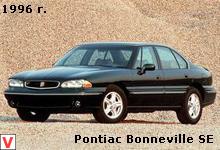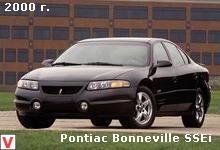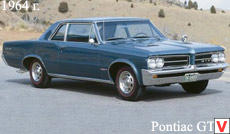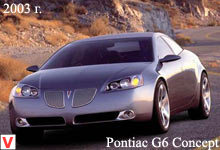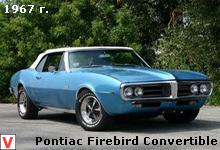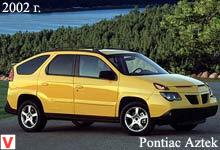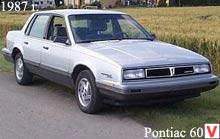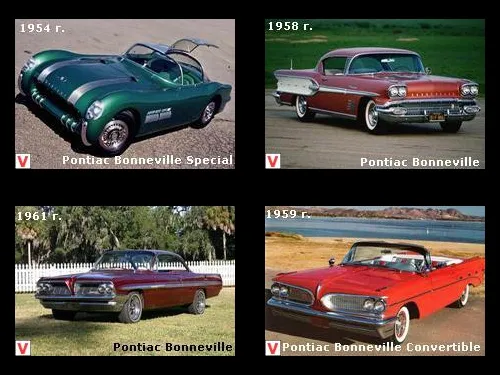
The prototype of a full-size rear-wheel drive luxury car with a transverse engine Pontiac Bonneville appeared in 1954. In 1957, mass production began, which continued at five US factories in 2005. In Canada, until 1981, it was known as Pontiac Parisienne. Similar models were the Buick Lesabre and Chevrolet Impala. The successor to the model was the Pontiac G8. In the first year of production, only 630 units of Bonneville were collected, which makes the surviving specimens among the most valuable for collectors. The car was equipped with a powerful 300-horsepower carburetor engine V8.
In the period from 1958 to 1961, the production of a full model range was launched, including a 2-door convertible, a 2-door coupe, a 4-door sedan and a 4-door station wagon with a hardtop body. In the 60s, the second-generation Bonneville model was the most expensive and luxurious among the Pontiac brand, which promoted the promotion of this branch of GM cars to third place in sales in the USA. In the version of Bonneville Brougham car interior was trimmed with walnut veneer, expensive materials, including leather, for the passenger was provided a mini-bar.

The model was based on the GM B platform. Standard equipment included the availability of an automatic transmission Hydra-Matic, power steering and brakes, air conditioning, power windows, electric seats, cruise control, radio and alloy wheels. Installed on the car engines V8 volume of 6.4 and 6.6 liters capacity from 303 to 340 hp, and since 1964 - 6.9 liters (376 hp). In 1967, the leadership of GM, it was decided to limit the power of 390 hp engines, just so had a new 7-liter V8. In 1969, its power was reduced to 360 hp, and in 1970, for the third-generation models, the 7.5-liter V8 with a capacity of 370 hp appeared.
In the design of the fourth-generation Bonneville, platform B was still used, instead of a station wagon, a 4-door sedan with a hardtop began to be assembled; The power of the 7-liter V8 engine became 325 hp, versions with the 6.6 liter engine were also produced. The reduction in engine power occurred as part of the program to reduce harmful emissions, as well as the impending energy crisis. Between 1973 and 1976, the power of a standard 6.6-liter engine dropped to 170 hp. In mid-1971, a new Turbo-Hydramatic gearbox and front disc brakes were installed on the car. By the beginning of the fifth generation of Bonneville (1977-1981), its production remained only at three GM factories.
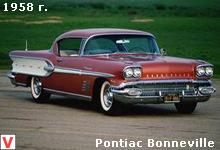
They collected cars in coupe, sedan and station wagon for 6 or 9 passengers. Only Bonneville (with a wheelbase of 2946 mm) remained in the Pontiac model range. The base V8 with a capacity of 5 liters and a power of 135 hp was installed on the car, versions with 5.7 liters (170 hp) and 6.6 liters (185 hp) were also offered. Production at plants in the United States was discontinued in 1981 due to low market demand, which in turn was triggered by another fuel crisis.
Since 1982, the Pontiac V8 engines also ceased to be assembled, later they began to be supplied from other GM branches: Chevrolet and Oldsmobile. The sixth generation of Bonneville was mid-size, it was based on the GM G platform; wheelbase decreased to 2743 mm. From 1982 to 1986, the Canadian branch of GM in Saint-Therese (Quebec) was engaged in the production of the car. Of the bodies were 4-door sedan and station wagon.
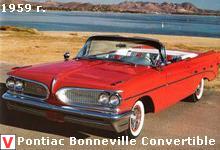
Gasoline engines V6 of 2.8 l and 4.3 l (Chevrolet) and 3.9 l (Buick), as well as V8 5 l from Chevrolet and diesel V8 5.7 l from Oldsmobile were aggregated with automatic transmissions: 3-speed TNM200 and 4-speed 200-4R. In 1987, the Bonneville production began again in the United States, now only in the sedan. The seventh generation was front-wheel drive, and its platform - again full-size (N), as a result, the wheelbase also grew - 2814 mm. There were several modifications: SE, LE. Dimensions differed slightly and amounted to 5037/1839/1410 mm. The power units from the Buick V6 3.8 l (150 hp) worked in tandem with a 4-speed automatic transmission TNM440T4.
The interior equipment included an on-board computer, an audio system, a key with remote door opening and much more. By the end of 1987, the car hit the list of the top 10 models of the year. In 1992, the modernization of the model continued, and production increased. Release of the eighth generation Bonneville was carried out until February 1999. The engine range consisted of five versions of the 3.8-liter V6 engine, and the transmission was represented by four types of 4-speed automatic 4T60 / 65. In 1996, the model was equipped with a supercharged version of the base engine (240 hp, 380 Nm). The length of the car grew by 10 cm, height by 1 cm, and width - by 5 cm.
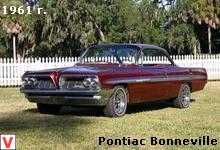
The design of the exterior and interior was completely changed. The car has become faster and, more importantly, safer; appeared in the standard equipment of the driver and passenger airbags, and as an option - ABS. The year 2000 was marked by the launch of a new, ninth generation Pontiac Bonneville in the SE, SLE and SSEi trim levels. The front-wheel drive 4-door 5-seater sedan had dimensions of 5145/1885/1440 mm with a wheelbase of 2850 mm and a gauge of 1590/1580 mm.
The luggage compartment volume was 510 liters. The curb weight of the car - 1720 kg. The minimum ground clearance was 135 mm. The car was completed with the already well-known overhead valves with a lower camshaft with V6 12V 3.8 liter engines (243 hp / 5200 rpm, 380 Nm / 3600 rpm) and 4.6-liter V8 from Cadillac. The dynamics of the 3.8-liter engine - 8.5 s to 100 km / h, the maximum speed - 220 km / h. The consumption of AI-92 gasoline in the urban cycle is 13.1 liters, on the highway 8.7 liters and in a mixed one - 10 liters per 100 km.
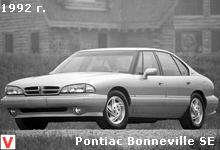
Motors are aggregated with 4-speed automatic transmissions 4T65-E, 4T65E-HD and 4T80-E. The front suspension consisted of a transverse lever, a spring-loaded rack and a transverse stabilizer, the rear one - of a double transverse lever, a spring and a transverse stabilizer. Front brake ventilated disc, rear - drum. The standard tire size is 235 / 55R17 or 225 / 60R16.
Other images auto Pontiac Bonneville
